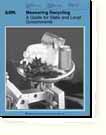Guidance Document
Note: EPA no longer updates this information, but it may be useful as a reference or resource.
Contact: ORCRMeasurement@epa.gov

Measuring Recycling: A Guide for State and Local Governments
describes in detail the voluntary, standard methodology for measuring recycling rates developed by EPA. It also includes a glossary of more than 100 terms, standard volume-to-weight conversion factors, and other useful tools. You can download the complete guidance document or sections of it below.Sections one through six constitute the introduction to the methodology; elements of standardization; planning, design, and implementation of a recycling measurement program; and program enhancement. In addition to explaining the essential elements of measuring recycling rates, the guidance document provides "real life examples, planning checklists,helpful hints and tips, and a recommended timeline for developing a measurement program.
You will need Adobe Reader to view some of the files on this page. See EPA's PDF page to learn more.
Measuring Recycling: A Guide for State and Local Governments (PDF) (164 pp, 2MB)
Section One: Introduction (PDF) (11 pp, 344K)
Section Two: Elements of Standardization (PDF) (10 pp, 143K)
- Standard elements
- Flexible elements
Section Three: Planning (PDF) (7 pp, 114K)
- Define your program goals
- Determine if useful data are already being collected
- Ascertain your authority to survey and collect data
- Determine who will collect recycling measurement data
- Decide on reporting requirements
- Establish program staff and budget
- Establish a timeframe for system development
Section Four: Design (PDF) (13 pp, 189K)
- Learn about your terrain
- Solicit input into the design of your system
- Determine what type of information is needed
- Determine whom to survey
- Address confidentiality guarantees
- Determine how to manage and analyze the information
Section Five: Implementation (PDF) (8 pp, 174K)
- Institute measures to increase your survey response rate
- Educate survey respondents
- Distribute survey forms
- Maintain frequent communication with survey respondents
- Compile data and calculate an MSW recycling rate
- Verify and double-check data
- Share information
Section Six: Enhancement (PDF) (3 pp, 101K)
- Expand or change data collection efforts
- Refine and modify survey forms
- Consider measuring source reduction
- Take advantage of electronic reporting
Appendix A: Glossary (PDF) (9 pp, 154K)
The glossary contains standard definitions for over 100 terms used in recycling measurement, from abatement debris to yard trimmings. Use of these standard definitions is essential to producing comparable recycling rates.
Appendix B: Standard Volume-to-Weight Conversion Factors (PDF) (4 pp, 64K)
Because some recycling and solid waste data are still obtained by volume (e.g., cubic yards), use of standard volume-to-weight conversion factors is an essential element of the recycling measurement method. EPA has provided conversion factors for everything from food scraps to appliances in this section.
Appendix C: Survey Forms (PDF) (34 pp, 514K)
The guidance document includes standard survey forms for states and local governments to use in obtaining the recycling and municipal solid waste (MSW) information necessary for calculating a standard recycling rate. These forms may be used by states and local governments that are measuring recycling for the first time or those redesigning their current program according to the standard method. Survey Forms 1 through 3 allow for the collection of data on the amount of MSW recycled in a state or locality and address collectors, processors, and end users of recyclables, respectively. Survey Forms 4 through 6 allow for the collection of data on the amount of MSW disposed of in a state or locality and address waste collectors, transfer stations, and disposal facilities, respectively.
Appendix D: Recycling Rate Worksheets (PDF) (26 pp, 410K)
Standard worksheets are provided in the guidance document to assist states and local governments in compiling data and calculating a standard recycling rate. Worksheet A (PDF) (7 pp, 88K), the ‘translator’ worksheet, is intended for those states and localities that have already calculated a recycling rate. The translator allows you to revise your recycling rate based on the EPA approach. Worksheets B1, B2, and B3 (PDF) (18 pp, 411K) allow states and localities wishing to use the EPA approach to compile data reported on the survey forms and calculate a standard recycling rate.
Appendix E: Resources (PDF) (6 pp, 82K)
To obtain more information about a particular state’s approach, consult the state environmental agencies listed in this appendix. This list also can be used by neighboring states wishing to coordinate their recycling measurement efforts, such as establishing similar deadlines for survey forms sent to private companies.
Appendix F: Sample Language for Freedom of Information (FOIA) Act Exemption (PDF) (1 pg, 67K)
This section contains an excerpt from a Florida statute that ensures the confidentiality of recycling data. It can be used by states and local governments as a model for developing their own legislative language.
Appendix G: Sample Cover Letters (PDF) (3 pp, 88K)
This section contains sample cover letters that states or local governments can send to recycling and solid waste facilities along with the survey forms.
Appendix H: Adjusting Waste Generation (PDF) (4 pp, 80K)
This worksheet contains a formula for adjusting waste generation survey data that were compiled in previous years to account for changes in population, employment, and taxable transactions.
![[logo] US EPA](../gif/logo_epaseal.gif)